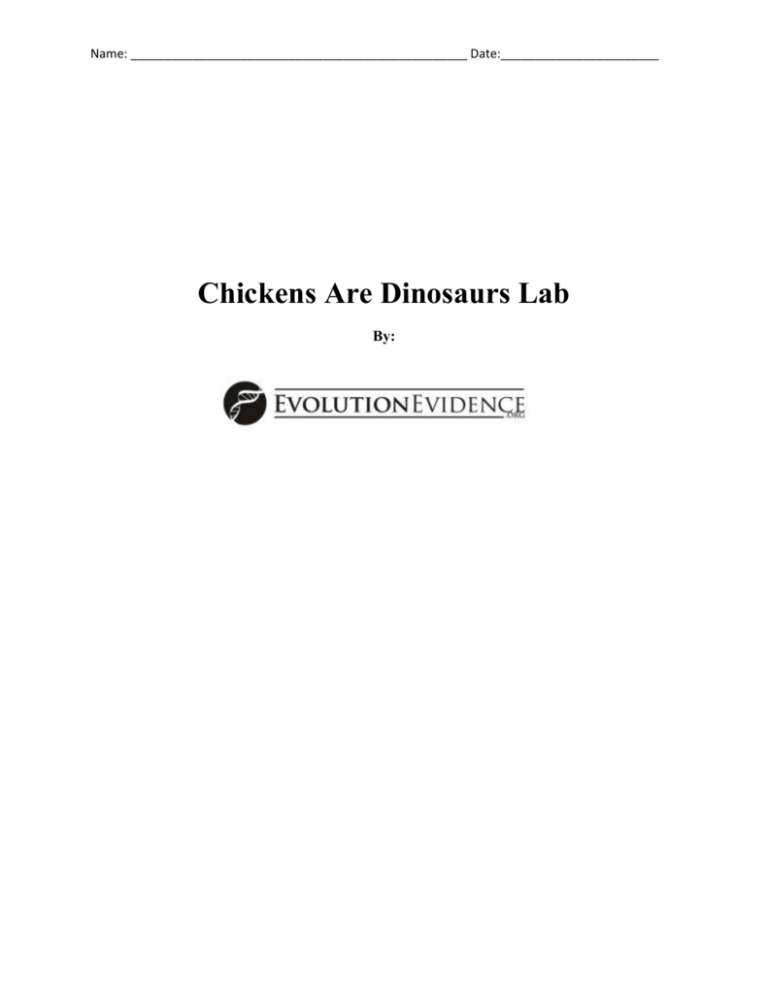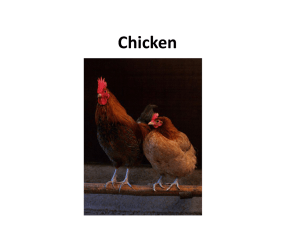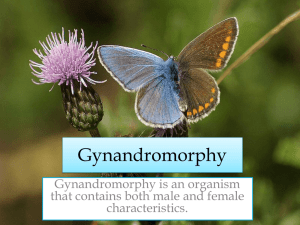- Evolution Evidence EvolutionEvidence
advertisement

Name: _________________________________________________ Date:_______________________ Chickens Are Dinosaurs Lab By: Name: _________________________________________________ Date:_______________________ Focus Statement: Students will dissect a chicken with the intent to see both the homology shared with dinosaurs as well as to find vestigial remnants of ancestral species. The intent is to have the student be able to see evidence in support of evolution in a very familiar context and also to relate evolution evidence to prior knowledge about chickens and dinosaurs. The habits of mind that the student will practice include looking for patterns of similarity between species and looking for vestigial remnants of past generations. Students will need to make careful observations as well as make inferences based on evidence. The lesson will be a guided exploration of the skeletal and superficial anatomy of a chicken. As the students dissect the chicken using standard dissection equipment they will be making detailed diagrams, listening to instructions, reading instructions, and drawing conclusions. Theme and Thinking Skills: Systematic observation, detailed note taking and sketching, inferences from evidence, Objectives: Student will be able to explain how vestigial structures support the theory of evolution. Student will be able to explain how homologous structures support the theory of evolution. Students will be able to explain why it is thought birds evolved from dinosaurs. Standards FL o SC.912.L.15.1: Explain how the scientific theory of evolution is supported by the fossil record, comparative anatomy, comparative embryology, biogeography, molecular biology, and observed evolutionary change. NGSS o HS-LS4-1.Communicate scientific information that common ancestry and biological evolution are supported by multiple lines of empirical evidence. [Clarification Statement: Emphasis is on a conceptual understanding of the role each line of evidence has relating to common ancestry and biological evolution. Examples of evidence could include similarities in DNA sequences, anatomical structures, and order of appearance of structures in embryological development.] Prerequisite Knowledge homologous structures vestigial structures common ancestry descent with modification how to dissect safely, effectively, and respectfully. Preassessment questions to gauge student’s prior knowledge: Why do scientists say birds evolved from dinosaurs? What fossil evidence is there to support that birds evolved from dinosaurs? What anatomical evidence is there to support that birds evolved from dinosaurs? Outline: Students will given an overview of bird evolution as relates to the dissection activity. Students will dissect a chicken in groups. Students will discuss and individually fill in a work sheet for a grade. Name: _________________________________________________ Date:_______________________ Time frame: 1 to 2 class periods. The chickens can be frozen, thawed, and have the lab resume at another time. Resources: PowerPoint presentation and lesson plans from: o http://www.evolutionevidence.org/lesson-plans-3/ Images of dinosaur and chicken homology: o http://bio.sunyorange.edu/updated2/wildlife/birds/aquatic/BIRD%20INTRO.htm o http://homepages.slingshot.co.nz/~elhong/chickenskeleton.html Materials: Whole, cooked chickens. These can be obtained from a local meat butcher. It is very important that the chickens are fully cooked to be sterilized. Raw chicken meat almost always has bacteria, such as Salmonella, growing on it. You must cook it before giving it to students. Dissection trays Scalpels Dissection pins Copies of “Chickens Are Dinosaurs” worksheet Attention Grabber and Intro: Is it possible for dinosaurs to be brought back to life, like in Jurassic Park? In the movie DNA samples were obtained by extracting blood samples from mosquitoes trapped in amber. DNA comes in long chains that over time break down into smaller chain portions. Over thousands of years the chains can become so broken up that it becomes impossible to read the DNA. That being the case, it is not feasible to obtain a sequence of dinosaur DNA even from the best possible sample. There is, however, another way that researchers are trying to use to recreate dinosaurs and it involves using species that are alive today. Birds are the direct descendants of dinosaurs. Researchers are trying to use this fact to reverse engineer a dinosaur from a chicken. For example, chickens don’t have teeth, but they do have a silenced gene that can be turned on again to create teeth. Chickens also don’t have tails or scales all over their body, but it may be possible to revive the mutated genes that control these traits, thus reviving much of the body plan their ancestors once had. Chicken Observation Procedures: Remind students to respect the lab equipment, each other, and the animals to be dissected. Scalpels are dangerous instruments, if misused. Have predetermined punishments for misuse of equipment or animals, or the endangering of other students. Students will begin making observations and recording data concerning the outside of the chicken. o Important external traits: the scales on the legs of the chicken the inside of the beak the number of toes the structure of the wing, including the vestigial finger o Semi-superficial traits Remove the skin from the wing to make the bone structure visible. Compare bone structure to the diagram in the handout. Have the student draw the bone structure and find homologous features. Make sure students identify humerus, radius, ulna, wrist bones, and digits Name: _________________________________________________ Date:_______________________ o Have the student remove the skin from the leg to make the bone structure visible. Compare bone structure to the diagram provided in the handout. Make sure students identify digits, femur, metatarsus, tibia, and fibula. Have the students remove the skin and muscle from the tail (pygostyle). As above, compare the tail to the diagram in the handout and have students draw the chicken’s tail. Deeper traits Have students remove breast muscle to see the wishbone. Compare wishbone to diagram in handout. Have students draw to compare shape. Closure: Have students come back to briefly discuss: What they saw. What they learned What obstacles might stop scientists from fully recreating a dinosaur from a chicken. Sources http://www.evolutionevidence.org/ o Offers lesson plans and power points on evolution evidence. http://www.nature.com/scitable/content/the-dino-chicken-project-4051061 o Nature article on making dinosaurs from chickens. http://kriegerscience.wordpress.com/2010/10/24/how-to-dissect-a-chicken-leg/ o Has pictures and gives an overview of chicken dissection. Accomodations: Students that are unable to perform the task of dissection because of moral or physical reasons will be allowed to watch or to visit the computer resource lab to perform and alternative writing and research task on evolution evidence. The learning objectives and vocabulary used during the lab will be prominently placed at the front of the classroom. Students will be allowed to work in groups that will facilitate informal discussion and questions by students that might not speak up to the broader class. Assessment (see worksheet) Name: _________________________________________________ Date:_______________________ Chickens Are Dinosaurs Worksheet Today you will explore some of the evidence that supports that the ancestors of chickens were dinosaurs. It is important that you be respectful to the animals we are dissecting and are extremely safe and cautious with the dissection tools. Materials: Chicken Scalpel Pins Dissection tray Instructions and Questions: Take a close look at the legs. Describe the appearance of the skin and any distinguishing characteristics. Also, record the number of toes. Look at the inside of the beak (if present). Describe the appearance of the beak and any distinguishing characteristics. Remove the skin and muscles from the wing to uncover the bones. Make sure that the bones remain intact. Sketch the bone structure below. Name: _________________________________________________ Date:_______________________ Compare the bone structure you drew above to this bone structure from an Archaeopteryx, which is a feathered dinosaur that could glide. Label the bones with numbers that you think are homologous. For example, put a 1 next to the humerus on the Archaeopteryx and then put a 1 by the bone on the chicken that you think is also a humerus, etc. Explain how the two arms are similar. Explain how the two arms are different. Remove the skin and muscles from the leg. Try to keep the bone structure intact. Sketch the bone structure below. Name: _________________________________________________ Date:_______________________ Compare the bone structure you drew above to this bone structure from an Archaeopteryx. Label the bones with numbers that you think are homologous. For example, put a 1 next to the tibia on the Archaeopteryx and then put a 1 by the bone on the chicken that you think is also a tibia, etc. Explain how the two arms are similar. Explain how the two legs are different. Name: _________________________________________________ Date:_______________________ Remove the skin and muscle from the tail. Sketch the bone structure below. Compare the bone structure you drew above to this bone structure from an Archaeopteryx. Explain how the two tails are similar. Explain how the two tails are different. Name: _________________________________________________ Date:_______________________ Remove the skin and muscles from around the base of the neck. Locate the wishbone and remove it carefully without damaging it. Sketch the bone structure below. Compare the bone structure you drew above to this bone structure from an Archaeopteryx. Explain how the two wishbones are similar. Explain how the two wishbones are different. Explain how the similarities you have seen between the chicken and the Archaeopteryx could be used as evidence in support of evolution.







